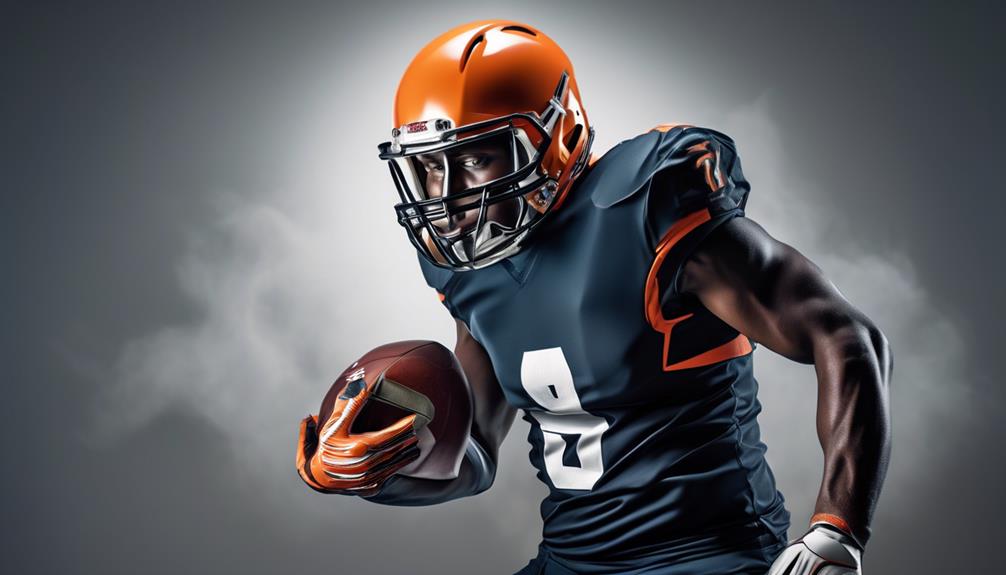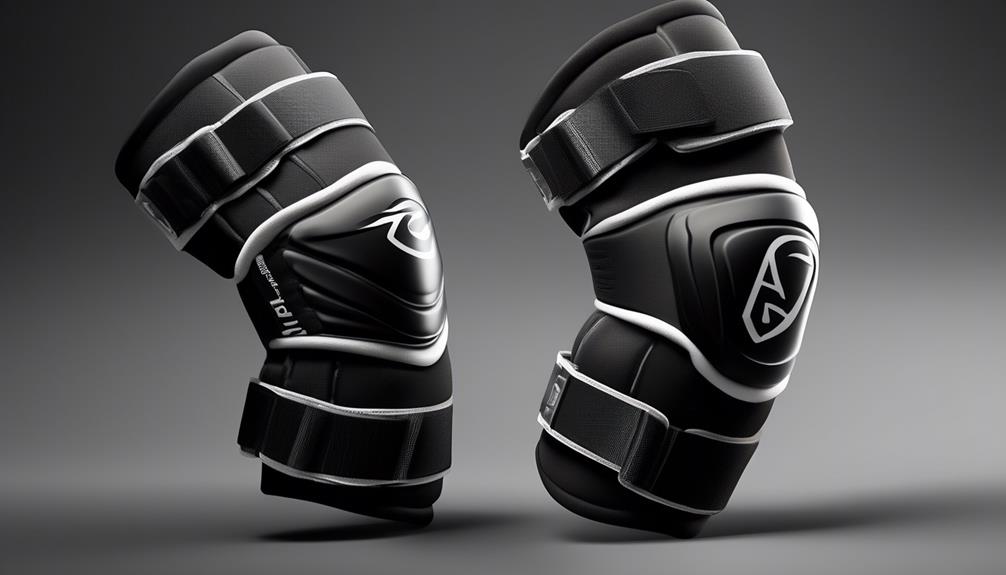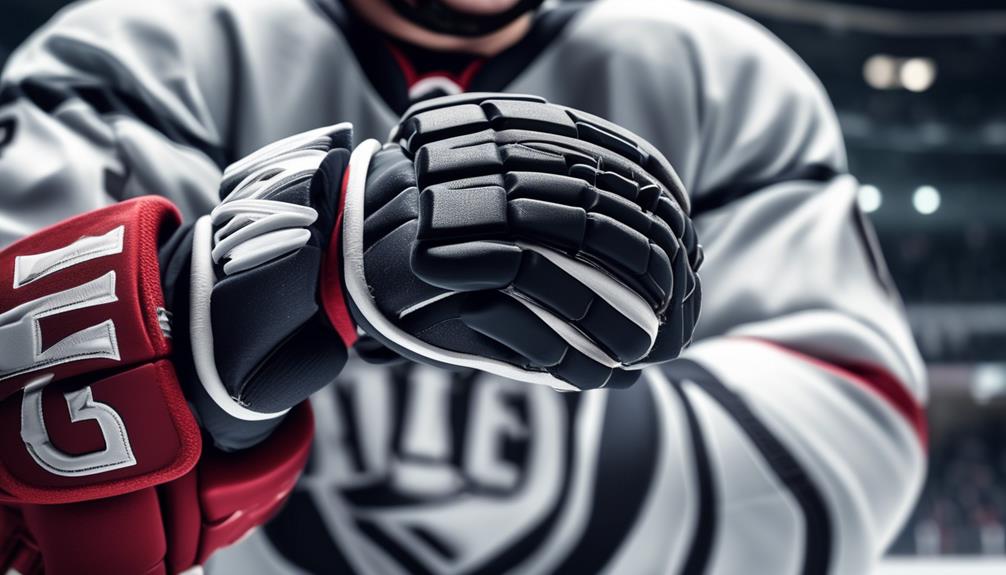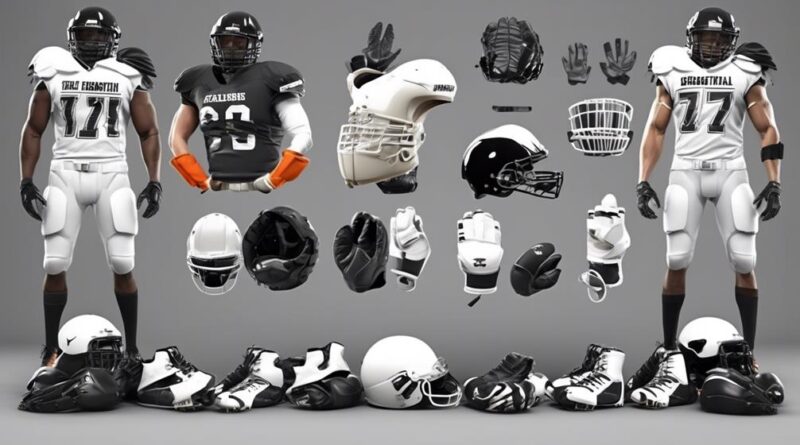Top Gear Every Defense Player Needs
Do you ever wonder what gear is essential for a defense player on the ice?
As a defense player, it's crucial to have the right equipment to protect yourself and excel in your position.
From head to toe, each piece of gear plays a vital role in keeping you safe and allowing you to perform at your best.
But what exactly are the top gear items every defense player needs?
Stay tuned to uncover the key essentials that will enhance your game and keep you secure on the ice.
Helmet and Visor

When choosing a helmet and visor for defense play, ensure that they provide maximum protection without obstructing your vision. Helmet safety is paramount in football, so always opt for a helmet that meets the safety standards set by the governing bodies. Look for features like impact absorption, a secure chin strap, and proper fit to minimize the risk of head injuries.
Additionally, visor benefits go beyond just style. A visor not only shields your eyes from the sun but also provides an extra layer of defense against potential eye injuries from impacts or debris.
Visor care is essential to ensure optimal visibility during games. Keep your visor clean by using a mild soap and water solution, and avoid abrasive materials that could scratch the surface. Regularly check for any cracks or damage, and replace the visor if necessary to maintain clear vision on the field.
Additionally, helmet customization is a great way to add a personal touch to your gear while maintaining safety standards. Many brands offer customization options, allowing you to choose colors, decals, and even add your name or team logo to your helmet.
Shoulder Pads
Ensure that your shoulder pads provide maximum protection and mobility, complementing the safety and functionality of your helmet and visor. When choosing shoulder pads for your defense play, it's crucial to prioritize proper fitting and material durability. Here are some key points to consider:
- Proper Fitting: Your shoulder pads should fit snugly, providing full coverage and protection without limiting your range of motion. Look for adjustable straps and customizable features to ensure a personalized fit that allows for comfortable movement while still offering maximum protection against impact.
- Material Durability: Opt for shoulder pads made from high-quality, durable materials that can withstand the rigors of intense gameplay. Look for reinforced padding and sturdy outer shells that offer reliable protection and can hold up to repeated hits and tackles.
- Comfort and Breathability: In addition to protection, prioritize comfort and breathability. Look for shoulder pads with moisture-wicking technology and ventilation channels to keep you cool and dry during extended periods of play. Comfortable shoulder pads will allow you to stay focused on the game without distractions from discomfort.
Choosing the right shoulder pads is essential for maintaining peak performance and staying safe on the field. By prioritizing proper fitting, material durability, and comfort, you can ensure that your shoulder pads provide the protection and mobility necessary to excel in your defensive role.
Elbow Pads

To enhance your defensive play, selecting elbow pads that offer both protection and flexibility is crucial. When choosing elbow pads, proper fit is paramount to ensure comfort and effectiveness on the field. The pads should fit securely without restricting your movement or sliding around during play. Look for adjustable straps or compression sleeves to customize the fit to your exact measurements. This won't only provide a better fit but also prevent the pads from shifting during intense game situations.
Impact protection is another essential feature to consider when selecting elbow pads. The primary function of these pads is to shield your elbows from potential injuries caused by falls, collisions, or contact with other players. Look for pads with high-density foam or gel padding strategically placed to absorb and disperse impact forces. This will minimize the risk of bruises, abrasions, or more severe injuries during gameplay. Some elbow pads even come with hard caps for added protection against direct impact.
In addition to fit and impact protection, consider the overall flexibility of the elbow pads. Defensive play requires a wide range of motion, so you need pads that allow natural movement without hindrance. Look for pads made from flexible materials and innovative design features that offer both protection and agility.
Shin Guards
Selecting the right shin guards is essential for enhancing your defensive performance and protecting yourself from potential injuries on the field. Proper fit is crucial when choosing shin guards. The right size will ensure that they stay in place during the game, offering maximum protection to your shins. When trying on shin guards, make sure they cover the entire shin area without being too tight or too loose. Additionally, consider the type of closure, whether it's Velcro straps, ankle guards, or slip-in shin guards, to find the most comfortable and secure fit for your playing style.
Maintenance tips are also important to keep your shin guards in top condition. After each game or practice, wipe down your shin guards with a damp cloth to remove any dirt and sweat that may have accumulated. This simple step helps prevent odor and bacteria buildup, prolonging the life of your shin guards. If your shin guards have removable padding or sleeves, be sure to take them out and wash them according to the manufacturer's instructions. Proper maintenance not only keeps your shin guards clean and hygienic but also ensures that they continue to provide the necessary protection for your shins during games.
Investing in shin guards that fit properly and maintaining them regularly won't only enhance your defensive performance but also help prevent unnecessary injuries on the field.
Hockey Gloves

When it comes to hockey gloves, just like with shin guards, finding the right fit is crucial for both performance and protection on the ice. Proper fit ensures that your hands are well-protected while allowing for maximum dexterity and control of the stick. When trying on gloves, make sure they fit snugly around your hands and wrists without restricting movement. A proper fit will also prevent the gloves from sliding around during gameplay, reducing the risk of hand injuries.
Durability and grip are also essential factors to consider when selecting hockey gloves. Look for gloves made from high-quality materials that can withstand the rigors of the game. Reinforced palms and padding in key areas provide added protection and durability, ensuring that the gloves can endure the demands of defensive play. Additionally, a good grip is crucial for stickhandling, passing, and shooting. Seek gloves with textured palms or materials that offer excellent grip, enhancing your control over the stick and puck.
When investing in hockey gloves, prioritize protection, comfort, and performance. A well-fitted, durable pair of gloves with excellent grip can significantly impact your defensive capabilities on the ice. By prioritizing these key features, you can ensure that your hands are adequately protected while maintaining the agility and control necessary to excel in your defensive role.
Stick
For optimal defensive play, ensure your stick is the correct length and has a comfortable grip to enhance your handling and shooting abilities. When it comes to stick handling, having the right stick can make all the difference. A stick that's too long or too short can hinder your maneuverability and impact your defensive performance. Additionally, the grip of your stick plays a crucial role in your ability to maintain control and execute quick, precise movements during gameplay.
Here are three key factors to consider when it comes to stick selection:
- Length: The length of your stick is essential for effective defensive play. A stick that's too long can be difficult to maneuver, especially in tight defensive situations, while a stick that's too short may limit your reach. Finding the right length that allows you to comfortably control the puck and execute defensive maneuvers is crucial.
- Flexibility: The flexibility of your stick can significantly impact your stick handling and shooting abilities. A stick with the right amount of flexibility can provide the necessary power for accurate shooting while allowing for better control during stick handling.
- Blade Curve: The curve of the stick's blade can influence your defensive capabilities. A blade with the right curve can enhance your ability to receive and control the puck, as well as execute accurate passes and shots.
When considering these factors, you can make an informed decision to select a stick that complements your defensive style and maximizes your performance on the ice.
Skates

Ensure your skates fit snugly and provide ample ankle support to optimize your agility and stability on the ice. Proper fitting and sizing are crucial to your performance and safety. When selecting skates, consider trying them on with the socks you intend to wear during play. Your toes should lightly brush the toe cap, and the skates should comfortably cradle your ankles. Ill-fitting skates can lead to discomfort and blisters, affecting your focus and speed on the ice.
Skate maintenance is essential for peak performance. Regularly check for signs of wear and tear, such as worn out blades or damaged eyelets. Keep your skates dry to prevent rust and odor. After each use, wipe them down with a dry cloth, and loosen the laces to allow airflow. Periodically, take your skates to a professional for sharpening. Dull blades can hinder your ability to make quick stops and maneuvers, impacting your defensive play.
When it comes to skate sharpening, the frequency depends on how often you play and your skating style. As a defense player, you rely heavily on your ability to pivot and change direction rapidly, so maintaining sharp blades is crucial. Consider having your skates sharpened every 10-15 hours of play to ensure optimal performance.
Protective Cup
To maintain peak performance on the ice, ensuring your protective cup fits securely and comfortably is essential for your safety and confidence during play. When it comes to protective cups, there are a few key aspects to consider to ensure you have the best possible defense on the ice.
- Sizing and comfort: Choosing the right size is crucial for both comfort and protection. A cup that's too small will be uncomfortable and restrict movement, while one that's too large may not provide adequate protection. Look for a cup with adjustable straps and consider trying on different sizes to find the best fit for you. It's important to prioritize comfort to ensure you can focus on your game without distraction.
- Maintenance and hygiene: Keeping your protective cup clean isn't only important for hygiene but also for its longevity. Wash it regularly with mild soap and water, and make sure it's completely dry before using it again. Inspect it for any signs of wear and tear, and replace it if it becomes damaged. Proper maintenance will ensure that your protective cup continues to provide the necessary level of protection.
Taking the time to find a protective cup that fits well and is properly maintained won't only enhance your performance on the ice but also give you the confidence to play your best game.
Frequently Asked Questions
How Often Should I Replace My Hockey Equipment?
You should replace your hockey equipment based on its lifespan and wear. Regularly check for damage and wear, and replace as needed. Properly functioning gear impacts your performance and ensures cost effectiveness in the long run.
What Is the Best Way to Properly Clean and Maintain My Gear?
To properly clean and maintain your gear, use gentle cleaning methods to avoid damaging the material. Regularly inspect and repair any wear and tear for long term maintenance. Proper care ensures your gear lasts longer and performs at its best.
Are There Any Specific Regulations or Guidelines for Hockey Equipment in Different Leagues?
When it comes to equipment safety, different hockey leagues have specific requirements for gear. Make sure to check the regulations for your league to ensure that your equipment meets the necessary standards for safety.
Can I Use the Same Equipment for Both Ice Hockey and Roller Hockey?
Yes, you can use the same equipment for both ice hockey and roller hockey, but there are some differences to consider. The pros are convenience and cost savings, but the cons include potential wear and tear and sport-specific gear requirements.
Are There Any Alternative Materials or Technologies Available for Hockey Gear That Players Should Consider?
When looking for hockey gear, consider sustainable options and performance enhancers. Look for custom-fitting equipment that provides impact resistance. These alternatives can improve your game and offer better protection for both ice hockey and roller hockey.
Conclusion
So, make sure you have all the essential gear to protect yourself on the ice.
Safety should always be a top priority when playing defense in hockey.
With the right equipment, you can focus on your game and be confident in your ability to defend the goal.
Stay safe and have fun out there!
